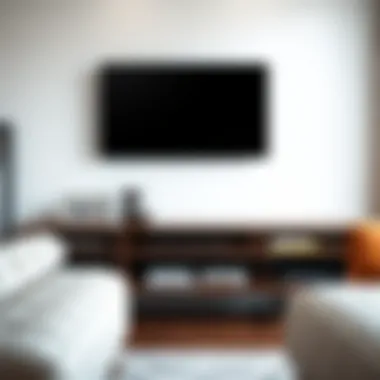Choosing the Perfect TV Stand for 80-Inch TVs


Intro
Choosing a TV stand for your 80-inch television isn't simply about aesthetics or room décor. It's a critical decision that balances style, function, and safety to ensure your massive screen has a sturdy base while complementing your home environment. As we plunge into this topic, let’s review what makes an ideal TV stand for a television of this size. We'll navigate through furniture styles, practical tips for selection, and features that enrich both usability and design.
In the following sections, we will unpack major considerations such as dimensions, weight capacity, materials, and even the all-important detail of cable management. This guide promises to equip homeowners, designers, and DIY enthusiasts with insights that will lead to an informed purchase. Stick around as we explore these crucial elements together.
Understanding the Importance of a Suitable TV Stand
Choosing a TV stand is more than just picking a piece of furniture to hold that sleek 80-inch screen. It's a crucial decision that can influence the dynamics of your living space, combining style with practicality. In this part, we will unravel why a suitable TV stand holds such weight in home design and functionality, especially when accommodating larger televisions.
A TV stand serves as the backbone of your entertainment setup, anchoring the room's aesthetic while also enhancing overall functionality. It provides a focal point for your living space, making it essential to select a piece that aligns with your decor. Imagine walking into a living room where the TV stands tall but looks out of place. It feels clunky, right? The right stand seamlessly fits into your space, improving both the look and feel.
Moreover, a well-chosen TV stand ensures that your television is at the right height for viewing comfort. An awkwardly positioned TV can lead to neck strain, ruining cinematic moments. So, keeping ergonomics in mind is not just a design choice – it's a health consideration too.
"The wrong stand can overshadow your expensive TV, turning the electronics into an eyesore rather than a centerpiece."
In terms of function, a TV stand can accommodate more than just the television. With multiple shelves and compartments, they can house gaming consoles, sound systems, and even decorative items, all contributing to a cohesive aesthetic. All those wires? They shouldn’t be a tangled mess if you opt for a stand designed with cable management features.
Beyond aesthetics and functionality, consider the practical aspect. A sturdy stand provides stability for your precious TV. Nothing is worse than the risk of a toppling television—especially a large one. To sum up, the choice of a TV stand goes beyond mere appearance. It impacts how well your space works and how safe it is, making it a fundamental element in your living space design.
The Role of a TV Stand in Living Spaces
The layout and function of your TV stand can significantly define a living space. It acts as a gathering point, inviting family and friends to come together for movie nights or game days. The strategic placement of the stand, whether against a wall or in the middle of a cozy arrangement, dictates the flow of how people move through the room. The right stand isn't just a nice-to-have; it typically shapes conversations and interactions.
Furthermore, the style and material of the stand can complement other furnishings, unifying the room's look. A well-chosen stand can create a modern vibe or enhance a traditional setting. It’s about creating a harmonious look that binds everything together.
Aesthetic Appeal Versus Functionality
Balancing aesthetics and functionality may sound like walking a tightrope, but it doesn't have to be complicated. When selecting a TV stand, consider the decor style of your home as a starting point. Is your space modern and crisp or warm and rustic? The stand must echo your chosen style.
On the flip side, functionality is equally paramount. Those shelves need to be wide enough for the gaming console and deep enough for that fancy soundbar. A beautiful stand that can't hold what you need it to is a short-lived triumph. Think about using materials that are easy to maintain. Wood has charm, but a glass front can add a contemporary flair while being easily cleanable.
In the end, it’s about compromise. A TV stand should reflect your personality and taste yet remain practical. Think of it like dressing for an occasion. It’s not just about wearing the trendiest outfit, but ensuring you’re comfortable and functional for whatever the day holds. Choosing a stand that nails both aesthetics and functionality gives you the best bang for your buck and keeps your space looking sharp.
Key Factors for Selection
When on the hunt for the perfect TV stand for an 80-inch television, a few critical factors tend to surface. It’s not just about placing a hefty screen atop a piece of furniture; it’s about harmony in aesthetics, space utilization, and the stand’s ability to support the TV while still being handy for users. Each factor plays a pivotal role in ensuring you achieve a functional and visually appealing living area.
Dimensions and Size Considerations
Height Requirements
The height at which your TV stand sits can dictate how you experience your viewing sessions. One of the more popular targets happens to be the eye level height, which generally resides between 42 to 48 inches when seated. This dimension supports a more comfortable neck angle over longer periods. Ensuring that the stand's height fits your furniture layout can aid in enhancing your overall viewing experience. Too low, and you’ll likely strain your neck; too high, and you may miss out on the nuances of the screen.
A particularly attractive aspect of appropriate height is its contribution to aesthetics. A well-placed TV can create a visual focal point in your room without making it feel cluttered. On the downside, a stand that's too tall could overshadow other decor elements in your living space.
Width and Depth Compatibility


Width and depth compatibility transforms how we integrate a TV stand into the room itself. The ideal stand should extend slightly wider than the TV base, ideally providing 3 to 6 inches of extra space on either side. This trick not only ensures a safe placement for your TV but also promotes a balanced look, allowing for decorative items or speakers to be showcased alongside.
Depth matters quite a lot too since the stand should not exceed the depth of the TV's back panel. A compact fit here reduces clutter and ensures that you maximize every inch of your living area. However, too much depth can hinder mobility, making it a tricky dance to find the right piece.
Material Choices and Their Implications
Wood Versus Metal
Both wood and metal bring their strengths to the table, with wood offering a warmth and character, while metal tends to manifest a more industrial vibe. Wood stands, especially those crafted with fine grain options like oak or teak, radiate durability and a classic elegance. They tend to pair beautifully with various decor styles, making them a favored choice for many.
However, metal has seen its day in the sun for its impressive durability and minimalism. It provides a clean, sleek look, is relatively lightweight, and often is easier to move around compared to their wooden counterparts. The downside might include scratch visibility on surfaces, which could be a buzzkill if you have children or pets running about.
Glass Inserts and Their Benefits
Incorporating glass inserts can add an extra layer of sophistication to a TV stand. This feature can create a sense of openness, particularly in smaller living spaces. Glass can reflect light, making a room feel more expansive, which is highly sought after. Another advantage is its ability to showcase items stored within the stand, allowing for personalized touches like books or decorative objects.
On the flip side, glass does demand more upkeep since it can easily show fingerprints and smudges, meaning a little more elbow grease is necessary to maintain that pristine look. Still, when blended seamlessly, glass can elevate the overall vibe of your living space.
Weight Capacity and Stability
Weight capacity often stands as the cornerstone of selecting a TV stand that won’t buckle under pressure. An 80-inch television weighs significantly more than smaller counterparts, and ensuring a stand can support this heft is non-negotiable. A sturdy stand will often have a weight rating listed in the specifications – always a crucial number to think about before making a purchase.
Stability is intertwined with this concept; a TV stand may feature a robust weight capacity, but if it’s designed poorly, it could wobble like a toddler on roller skates. Look for wider bases or specific features like adjustable feet to enhance steadiness, offering peace of mind that your prized possession won’t meet an untimely end.
Design Styles to Consider
Choosing the right TV stand for an 80-inch television is not just about function; it’s also about style. The design of the TV stand can dramatically shape the aesthetic of your living area. The charm is in finding that sweet spot between what you love and what complements your home’s decor.
When considering design styles, think about how different aesthetics align with your overall theme. A well-selected TV stand can act as a focal point or seamlessly blend into your surroundings. Factors like color, material, and shape play crucial roles in this equation. Whether you lean toward modern sleekness, traditional warmth, or rustic charm, the design style you choose should reflect your personal taste and suit your living space.
Modern and Minimalist Designs
Modern and minimalist designs emphasize simplicity, clean lines, and functional elegance. This style is ideal for those who appreciate a clutter-free space. Look for stands made from materials like metal or glass, often featuring geometric shapes that appeal to contemporary aesthetic values.
Here are some benefits to consider:
- Space Efficiency: As these designs focus on minimalism, they often take up less space while providing ample support.
- Versatility: Modern designs can adapt to various themes; they often pair well with a range of furniture styles.
- Visual Lightness: The use of glass or light materials can create an airy, open feel to a room, especially in smaller spaces.
Embrace this style if you value a streamlined look that elevates modern tech without overshadowing it.
Traditional and Classic Aesthetics
If you find charm in nostalgia, traditional and classic aesthetics might just be your cup of tea. These designs often feature rich wood grains, ornate carvings, and warm tones, which create a cozy and inviting atmosphere.
Key aspects include:
- Timeless Appeal: Classic designs never go out of style. They invoke a sense of comfort and permanence.
- Rich Materials: The use of solid woods provides both durability and warmth, making them a great choice for family-oriented homes.
- Detailed Craftsmanship: Look for features like hand-carved details or intricate moldings that showcase quality craftsmanship.
This design might resonate with you if you wish to foster a welcoming environment steeped in tradition.


Industrial and Rustic Options
Industrial and rustic styles introduce an edgy, raw character to a space. Think exposed materials, distressed finishes, and vintage elements. Such designs help you tell a story about your space—often harkening back to old factories or countryside cabins.
Consider these benefits:
- Unique Character: Each piece may have its own personality due to the nature of the materials.
- Robust and Durable: Industrial designs often incorporate metals or reclaimed wood that withstand the test of time.
- Versatile Pairing: They can be a great contrast to modern furnishings, making them an intriguing choice for eclectic decor.
If you’re drawn to textures and authenticity, an industrial or rustic TV stand could be a perfect match for your lifestyle and design sensibility.
Essential Features in a TV Stand
When determining the best TV stand for your 80-inch television, certain features are essential for maximizing both functionality and aesthetic appeal. The right stand not only supports your television securely but also enhances your living space by marrying form and function. With a large screen, particular attention must be paid to the design, structure, and additional capabilities of the stand to ensure it meets your needs fully.
Storage Solutions
Shelves and Cabinets
The use of shelves and cabinets in a TV stand cannot be overstated. These components serve as practical solutions for organizing media devices, gaming consoles, and other accessories. A well-designed shelf layout allows you to keep everything at arm’s reach, decluttering your space while providing an easily accessible setup.
What makes shelves and cabinets a popular choice is their versatility. They can come in various sizes and configurations, which means you can find a combination that suits your specific requirements. For instance, open shelves can showcase decorative items such as vases or books, while cabinets can hide less visually appealing gadgets or even an unsightly collection of cables.
One unique feature of shelves is their adaptability; many modern TV stands allow you to adjust the height or spacing to fit larger devices or personal items, making them a smart addition. However, do be aware that open shelving might collect dust more quickly, which could lead to additional maintenance.
Drawer Options
When discussing drawer options, it becomes clear that they significantly enhance the organization of your entertainment area. Drawers offer a hidden storage solution that keeps clutter under control and items organized. One major advantage of having drawers in your TV stand is the added security they provide. Unlike open storage, which leaves items exposed, drawers can keep everything more private and tidy.
The unique feature of drawers is their capacity to store a variety of items—from remote controls to gaming accessories—without taking up additional floor space. This makes them particularly suitable for homes where space is a premium. A drawback, however, is that if not crafted well, they may stick or be hard to open, especially when loaded with heavier items.
Cable Management Systems
Cable management systems are an often-underappreciated aspect of TV stands. A well-implemented system can drastically reduce unsightly cables that clutter your living area and provide safety by reducing trip hazards. Many modern stands feature built-in cable clips and channels that seamlessly hide cords, keeping your setup looking neat and professional.
Consider selecting a stand that excels in this aspect. This will save you time and frustration during setup and provide a more streamlined, sophisticated look that contributes to the overall design appeal of your space.
Mobility Features
Fixed versus Adjustable Stands
When it comes to mobility, one must weigh the options between fixed and adjustable stands. Fixed stands are stable and straightforward, making them an appropriate selection for a permanent setup in rooms where things exhibit no frequent movement—like a dedicated media room.
On the other hand, adjustable stands allow for flexibility, adapting to changing needs over time. For example, if you decide to rearrange your space or relocate to a new home, as the stand can be modified to fit any new layout. A notable drawback of fixed stands can be the additional effort required to move them, should the need arise, while adjustable options can lack some of the robust stability.
Swivel and Rolling Options
Swivel and rolling options introduce an innovative level of adaptability to furniture design. A swivel feature allows the screen to tilt and turn, catering to various viewing angles, especially beneficial in larger rooms where seating arrangements may vary. Rolling options, on the other hand, bring forth the ultimate flexibility. You can easily move your TV stand to different locations as required—ideal for gatherings or events where viewing access is crucial.
However, rolling stands must come equipped with dependable locking mechanisms to ensure stability during use and avoid any mishaps.
Ultimately, the essential features of a TV stand—storage solutions, cable management systems, and mobility attributes—contribute significantly to the overall experience of owning an 80-inch television. Each consideration ensures that aesthetics and functionality do not just coexist but enhance one another, leading to a satisfying and visually appealing setup.
Budget Considerations
Budgeting plays a pivotal role in selecting the right TV stand for your 80-inch television. It is not just about making a purchase; it's about investing in a piece of furniture that should support both your TV and your lifestyle. A well-thought-out budget allows you to prioritize features that are genuinely essential while avoiding the pitfalls of overspending or settling for subpar options.
When one sets out to choose a TV stand, the budget must be framed not just around the cost of the stand, but also considering other elements like delivery fees, assembly costs, and potential accessories such as cable management solutions. The right budget approach ensures that you won’t be backed into a corner where you compromise on quality or functionality.
Setting a Reasonable Budget
Setting a reasonable budget for a TV stand involves understanding your financial range and the value you expect from the purchase. A good rule of thumb is to allocate around 10% to 20% of the TV’s price on the stand itself. For an 80-inch TV that may cost anywhere from $1,000 to $3,000, budgeting approximately $100 to $600 for the stand seems pragmatic. This involves gathering some ground data on various price points. Look for stands that are not just affordable but also carry that assurance of quality.


It’s worth noting that in the long run, opting for a cheaper stand can turn out costly. A flimsy stand may not support the weight of the TV and can create an unnecessary headache down the line. Not only could it damage your TV, but it may also lead to replacement costs.
Evaluating Value for Money
Value for money is a sensitive scale, particularly when it comes to furniture. Purchasing a TV stand that strikes the optimum balance between cost and quality is paramount. Evaluate stands based on their construction materials, style, and additional features—items like storage solutions or cable management can enhance functionality significantly.
Here’s what to keep in mind when thinking about value for money:
- Materials Used: A solid wood stand may come with a higher initial cost, but its durability potentially saves costs on replacements.
- Functional Features: Look for practical features. For instance, stands with built-in shelves and cabinets can eliminate the need for purchasing additional shelving.
- Warranty and Brand Reputation: A company that offers a good warranty is a sign of confidence in their product. Check reviews and ratings before making your decision.
By taking a hard look at these factors and aligning them with your budget, you’ll likely find a stand that fulfills your requirements without digging too deep into your pockets. As the saying goes, "Penny wise, pound foolish"—sometimes that extra bit of spending now can save you a lot in the future.
Additional Tips for Selection
When it comes to choosing the right TV stand for an 80-inch television, making a decision can sometimes feel like trying to find a needle in a haystack. With so many options out there, you may need some pointers to help you navigate the landscape. This section provides key insights into the elements that can enhance your shopping experience, ensuring that you make an informed decision that meets your needs and preferences.
In-Store versus Online Shopping
Both in-store and online shopping hold their unique advantages. Depending on your personal preferences and lifestyle, you might find one method to be more beneficial than the other.
- Tactile Experience: Browsing in a physical store allows you to touch and feel different materials, giving you a better grasp on quality. Seeing the TV stands in person helps visualize how it’ll fit in your space.
- Visual Inspiration: Here, you can find inspiration through showroom setups. Sometimes seeing how a stand interacts with a TV and surrounding decor can spark ideas you hadn't even considered.
- Convenience of Online Shopping: On the other hand, purchasing online provides convenience. You can explore countless options from the comfort of your home and often find a broader range of styles that might not be available locally.
- Comparing Prices Easily: Online shopping generally allows for quick price comparisons—one click and you can see alternative options, ensuring you’re getting good bang for your buck.
Ultimately, weigh these advantages against your personal shopping style. If the tactile experience is essential, perhaps a trip to a store is in order. If you prefer comprehensive browsing, the online route may be more suitable.
Reading Customer Reviews
One of the best ways to gauge a product's performance is to check out customer reviews. Reading what others have to say provides real-world insights that you can’t always find on the product description.
- Quality Assessment: Comments about the durability of the materials used or everyday functionality can help you understand the stand’s long-term value.
- Installation and Setup: Consumers might share experiences regarding how easy or challenging assembly was, which is critical if you’re not accustomed to putting furniture together.
- Design Complaints or Praise: You might also learn about any design mismatches that could arise, like how a stand looks once it’s set up in a home environment compared to just seeing product photos.
- Customer Service Experiences: Reviews often include details about the company's service during and after purchase, which can be a decisive factor, particularly for larger purchases.
With the attitude of "knowledge is power," analyzing reviews can arm you with the information needed to make an informed decision. Whether you find a sliver of praise or a string of complaints, every piece of feedback counts.
Seeking Professional Advice
Sometimes, the best path to properly selecting a TV stand is to tap into the expertise of professionals. Seeking expert advice can bring clarity amidst the confusion.
- In-Store Specialists: Store associates often have valuable knowledge about the products they sell. Do not hesitate to ask them which stands pair well with larger TVs or come highly recommended.
- Interior Designers: If you're looking to fit your TV stand into a broader design scheme for your living space, consulting with a professional designer can provide tailored suggestions. They can help adapt your choices to seamlessly integrate with your decor.
- Online Forums and Communities: Platforms like Reddit have threads where design enthusiasts share their own experiences and recommendations regarding TV stands. These kinds of insights can steer you toward choices you may not have considered otherwise.
Epilogue
Selecting the ideal TV stand for an 80-inch television is no simple feat; it involves a careful balance of aesthetics, practicality, and security. A suitable stand not only enhances the visual appeal of your space but also plays a critical role in ensuring the stability and longevity of such a significant investment. Therefore, it's essential to consider various elements that pair the functional and stylish aspects of your choice.
Recap of Important Considerations
It's easy to feel overwhelmed by the multitude of choices available in the market today. Let’s break down some of the key points to bear in mind:
- Dimensions and Size: The stand must properly accommodate the television’s size and weight. An 80-inch TV is hefty, so ensure the stand has the right dimensions and weight capacity.
- Material: The material of the TV stand can vastly impact the overall look and sturdiness. Wood, metal, or a combination can create varied aesthetics; however, make sure it is robust enough to hold the weight and withstand occasional bumps.
- Design Style: Think about what fits best with your living space. Whether it’s modern, industrial, or rustic, the design should align with your home’s décor.
- Storage & Organization: TV stands often come with shelves or cabinets. Use these wisely to store equipment and declutter your space.
Remember, the TV stand does more than merely hold your TV; it can shape the ambiance of your room.
Final Recommendations
- Measure and Plan: Before shopping, measure the space where the TV stand will go—not just the width and height of your planned TV stand, but also the distance between the TV and seating area to ensure everyone has a good view.
- Invest in Quality: It might be tempting to go for cheaper options, but investing in a durable stand will save you money in the long run. A good stand provides security and can elevate the overall look of your room.
- Consider Future Upgrades: If you plan to upgrade your TV or associated equipment later on, leave room for flexibility. By choosing a versatile design or sizing slightly larger, you may save yourself the hassle of replacing furniture too soon.
In combination, these considerations and recommendations will guide you in selecting not only a practical and visually appealing stand but also one that safeguards your sizable television investment for years to come.







